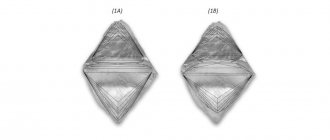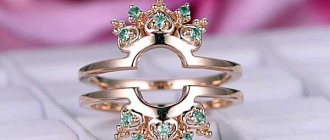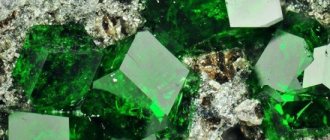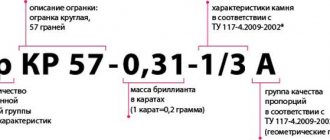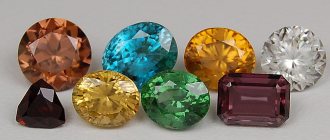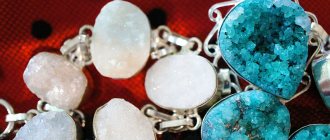Rose cut
Rose cut
It is a facet cut without a platform and a lower part. Depending on the number and shape of the facets, there are varieties - Dutch rose, Antwerp rose, half-Dutch rose, double Dutch rose and others.
The base of the stone in this case is flat, and the crown consists of triangular faces, usually 12 or 24, arranged symmetrically. As a rule, the stone has a round shape. The exceptions are the briolette, Antwerp rose and double Dutch rose cut types.
The rose cut is the first cut to use flat facets. The name of this form is explained by the similarity of the arrangement of facets in the stone with the petals of a well-developed rose. This cut was widely used until the 17th century, but is now rarely used, mainly when processing small fragments of stones; in the Victorian era it was used to cut dark red garnets, which were very fashionable at the time.
Rose-cut stones have facets only in the upper part, and the lower part is a flat ground base. The upper part is shaped like a pyramid with triangular facets meeting at an angle at the top of the stone. The simplest forms of rose cutting are the Atwerp or Brabant rose. In these forms, the facets are arranged in two groups with a number of facets that are a multiple of 6: the first group of six facets forms the crown or star, the second group will form the lower part of the stone. Other varieties of rose cut are also known, these include: Dutch or royal full rosette (rose), Dutch half rosette, cross rosette, recoupee and others. An example of the largest diamond rose is the Great Mogul diamond.
In Dutch and royal roses, the height of the facet pyramid is half the diameter of the stone, the distance of the crown from the base is 3/5 of the full height of the stone, the diameter is about 3/4 of the base, which can be round or oval. In Atwerp and Brabant roses the faceted pyramids are lower; the number and shape of the facets of the lower part of the stone changes. The cross rose and recoupee differ in the shape of the facets. For example, the crowns of the recoupee rose form triangular facets, and the cross rose - quadrangular and diamond-shaped. The lower parts of the crown are also constructed differently. If the shape is double, which can be described as two simple shapes connected at the base, a beautiful briolette in the shape of an elongated drop is obtained. In addition, other forms of rose cutting are known.
Types of cuts and number of facets
Let us briefly describe the most common modern cut forms used by jewelers today.
- Round form. The most popular form of diamond cutting. Depending on the size of the original diamond, it can have 17, 57 or 85 facets.
- Oval shape. Traditionally, it has 57 sides.
- Marquise cut. Fantasy shape: elongated oval with pointed edges. Has 55 edges.
- Princess cut. Rectangular shape, the most popular among straight cut diamonds. Contains 65 edges.
- Asscher cut. Rectangular shape, a combination of radiant and emerald (step) cut. The number of facets depends on the size: 49, 57 or 75 faces.
- Emerald cut. Straight cut with steps. Has 65 edges.
- Pear cut. Has the shape of a drop. The number of facets is 65.
- Trilliant cut. A triangular diamond that most often has 52 facets. However, their number may be different - from 31 or more.
- Radiant cut. Rectangular or square wedge cut. Contains from 65 to 89 facets.
- Cushion cut. A square or rectangular diamond with rounded edges. As a rule, it has 64 sides.
- Heart cut. Fantasy form. Has 56-58 sides.
You can purchase diamonds of all cutting shapes, different weights and colors in our showroom. We work directly with manufacturers of precious stones, thanks to which we maintain optimal prices, “without mark-ups.” The quality of diamonds is confirmed by a certificate from the independent gemological center of Moscow State University. Come and choose your diamond!
Type classification of cut and diamond structure
A diamond is characterized by its cut and appearance. If you look at the stone from above, the geometric outline will show the view. The location designation and the difference between the edges determine the cut. The introduction of new technologies and creative searches by jewelers give birth to new types of cutting. All of them are subject to the laws by which the stone is ground.
The structure of the crystal and its weight influence the choice of type and cut. Processed diamonds are characterized by clear parameters. The markings of the diamond are perfectly aligned. A properly cut diamond, regardless of type, consists of three parts:
- The crown is the upper part that defines the look. A reflection of light is visible through it. Consists of a flat surface called a platform, to which are adjacent the main faces of the top, single star facet wedges, and a number of paired top wedges.
- Girdle - a strip that separates the lower part from the upper. Such processing is appreciated in which the girdle looks like a thin light line. This is the supporting part that is usually attached to the decoration. The quality of this belt is characterized by the skill of the cutter. When examined under a magnifying glass, it looks rough and matte. Sometimes it is polished, but complete transparency and smoothness will reveal a fake.
- Pavilion - the lower pointed tenon, consists of a facet of the bottom and a series of wedge-shaped edges of the bottom. Kalette is the lowest point where the edges meet. The standard for the tenon is 43.4% of the diameter of the diamond. If the pavilion is short or too elongated, the light flux is not reflected from the lower edges. The radiant mystical shine for which the decoration is valued is lost.
Jewelers use all kinds of cuts or combinations of them to inlay jewelry.
Marquise cut
“Round” or classic cut with 17 and 57 facets
This is the most commonly used type of cut. Up to 90% of diamonds are cut with it. Suitable for all sizes of original diamond. Jewelers claim that with this treatment, the beam entering through the upper platform is ideally transformed, and the lower edges reflect the beam in the best way. A unique diamond reflection is created, including the entire spectrum of rainbow shades.
The number of facets also depends on the weight, which is measured in carats. One carat weighs 0.02 grams. Thus, gemstones up to 0.03 carats are processed into 17 facets; from 0.03 to 0.05 carats – by 33; A diamond of 1 carat or more receives a classic cut consisting of 57 facets.
Large diamonds are sharpened to 73, 86 is the “royal cut”, and the largest ones, called “majestic radiance”, are sharpened to 102.
"Oval" cut
The name characterizes the type of site. The classic Oval diamond cut has been around for over six decades. The elongated shape is given by wedges elongated on two opposite sides; it has a 57-carat diamond. Decoration with an “Oval” crystal will especially emphasize the grace of the hand.
Princess cut
"Fancy" cut and its types
The characteristics of the crystal structure influence the choice of the “Fancy” cut. Diamonds with this treatment are conventionally divided into three groups:
- Modified, or wedge, cutting of diamonds into brilliants is more common than others. A new form is created based on the existing one. The number and position of edges remain unchanged. In terms of reflection, they look like round decorations. This type includes “Marquis”, “Pear”, “Heart”, “Cushion”.
- Step processing is applied to square, rectangular, trapezoidal types of stones. The edges along the girdle emphasize color and transparency. “Emerald” and “Baguette” are examples of such turning.
- The mixed cut combines the advantages of the first two types: step - for maximum weight retention and crown - for revealing light-refracting properties. The classic crown was first combined with a stepped pavilion more than sixty years ago.
Princess cut
“Princess” is a decoration of a square, less often rectangular, type with sharp corners. The second most common species. Not inferior to “Round” in brilliance. When cutting, there is less material loss. Meets high requirements for a diamond. It first appeared in the mid-twentieth century. Wedding rings and rings are often decorated with this type of gemstone. Used for inlaying crowns and geometrically correct products.
Important! When choosing a decoration of the “Princess” type, pay attention to the protection of sharp corners, the weak point of this shape.
Marquise cut
Its origin is told by a beautiful legend that Louis XV gave his favorite Marquise de Pompadour a luxurious diamond reminiscent of her smile. Hence the name "Marquis" is borrowed. The appearance is oblong with pointed ends in the shape of a “boat”. Sometimes they are called "Cat's Eye" or "Shuttle". Looks great when paired with a small crystal headband. Diamonds of this type are used to decorate brooches, bracelets and other jewelry pieces.
It is important to remember that the Marquise decoration should be handled carefully: its wedge-shaped ends are thin and very fragile.
Heart cut
Radiant cut
The romantic symbol of love is embodied in jewelry. The first mention of a heart-shaped diamond dates back to 1463 and is associated with the name of the Duke of Milan. There is evidence of Queen Mary Stuart's gift to Elizabeth I of a heart-shaped ring with a crystal. The modified “Pear” with a notch at the top has an octagonal platform, 57 or 58 sides and plays beautifully in the rays of light. To maintain strength, the width and length are in a 1:1 ratio, which reduces the risk of damage to the decoration.
Radiant and Asscher cut
The “Radiant” gem was first demonstrated in Amsterdam in the seventies of the last century and became widespread. It has the shape of a rectangle or square with beveled corners. Typically made with 61 or 77 edges. Refers to the stepped type. The cut was obtained by combining “Princess” and “Emerald”. The absence of sharp corners increases strength and allows the stone to be better secured in the setting. The unique arrangement of the facets enhances the color and is therefore particularly suitable for tinted diamonds.
"Asher" is a modified "Emerald". A square platform with beveled corners is bordered by three steps of cutting the crown into 49, 57 or 75 facets. The ground edges of the chamfers create a diagonal cross shape. This is its main feature. Developed about 120 years ago by the Usher brothers.
Rose cut
Rose cut flower shape
The first known cut to resemble rose petals. Widely used until the seventeenth century. The peculiarity is that the edges are located only on the crown, and the pavilion is either absent or smoothly ground. The classic “rose” has 24 sides. Currently used for processing diamonds weighing no more than 2 carats. Due to the combination of beauty, brilliance and relatively low cost, it is successfully used in the mass production of jewelry.
Pear and Cushion cut
The combination of the two cuts “Marquise” and “Oval” gives the “Pear” shape. Refers to fantasy processing. One side is pointed and the other is rounded. A diamond with 56 facets resembles a drop. The elongated shape will decorate earrings and pendants. Used for cutting large diamonds.
One of the most famous yellow diamonds, the Sundrop, weighing 110.03 carats, sold in 2011 for $12.4 million, belongs to this type of cut.
Wide edges and rounded corners are characteristic features of Cushion. Its second name is candle diamond. The light from the fire plays expressively on the edges of the quadrangular stone.



